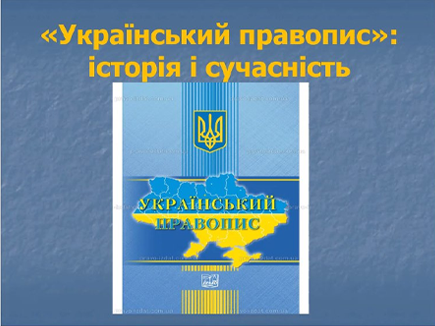З нагоди відзначення Дня української писемності та мови 30 жовтня 2025 року доцентка кафедри української мови та журналістики Валентина Юносова прочитала для здобувачів вищої освіти соціально-гуманітарного факультету лекцію «Український правопис: історія і сучасність».
Метою лекції було систематизувати та поглибити знання здобувачів щодо формування правописних систем української мови впродовж століть, сприяти усвідомленню процесів історичного розвитку української орфографії та свідомому застосуванні норм чинного правопису 2019 року.
Лекторка розповіла про тривалий і непростий процес прийняття єдиного правопису української мови, в якому відбивається вся складність долі української писемно-літературної мови. Зокрема, зауважила, що вік нашого правопису налічує сотні років! Через те в ньому існують елементи, усталені ще в сиву давнину, та елементи, котрі з’явилися зовсім недавно. Тільки впродовж 1798-1905 рр. було створено близько 50 більш-менш поширених, інколи взагалі індивідуальних правописних систем. Їх називали часто за прізвищем їхнього автора: кулішівка, драгоманівка, желехівка, грінченківка. І лише відновлення української державності спонукало до вироблення загальноприйнятного нормативного правописного кодексу української мови – офіційно затверджених та обов’язкових для всіх правил орфографії.
Особливу увагу звернено на Український правопис 1928 р., який кодифікував фонетичну й морфологічну структури української мови, ставши соборною українською орфографією, що об’єднала дві тогочасні правописні традиції – наддніпрянську і наддністрянську. Це був перший загальноукраїнський правопис. Однак у добу розстріляного відродження знищено або зацьковано більшість авторів харківського правопису 1928 року, сам правопис було перероблено. Упродовж наступних десятиріч у правописи 1933, 1946, 1960 рр. було внесено понад 120 (!) суттєвих «поправок», що ретельно спрямовані на наближення, точніше уподібнення українського правопису з російським. Усі ці правописи були радянською версією української мови. І лише з набуттям Україною незалежності стало можливим повернути українську правописну систему до питомих національних джерел.
Детальніше було зроблено огляд чинного правопису щодо наявності в ньому орфографічних варіантів та причин їхньої появи.
Викладачка наголосила, що мову береже не тільки закон, а й сам народ у своїй повсякденній мовній практиці, і закликала всіх дбати про мову і досконало оволодівати її орфографічними нормами.

За інформацією кафедри української мови та журналістики
Spelling that Shapes the Nation

On the occasion of the Day of Ukrainian Writing and Language on October 30, 2025, Associate Professor of the Department of Ukrainian Language and Journalism Valentyna Yunosova gave a lecture “Ukrainian Spelling: History and Modernity” to students of the Faculty of Social and Humanities.
The purpose of the lecture was to systematize and deepen the students’ knowledge of the formation of spelling systems of the Ukrainian language over the centuries, to spread awareness of the processes of historical development of Ukrainian orthography and the conscious application of the norms of the current spelling of 2019.
The lecturer spoke about the long and difficult process of adopting a unified spelling of the Ukrainian language, which reflects the complexity of the fate of the Ukrainian written and literary language. In particular, she noted that the age of our spelling is hundreds of years! That is why there are elements in it that have been established since ancient times, and elements that have appeared quite recently. Only during the years 1798-1905, about approximately 50 widespread, sometimes even individual spelling systems were created. They were often called by the surname of their author: kulishivka, dragomanivka, zhelehivka, grinchenkovka. And only the restoration of Ukrainian statehood prompted the development of a generally accepted normative spelling code of the Ukrainian language – officially approved and mandatory for all spelling rules. Particular attention was paid to the Ukrainian Spelling of 1928, which codified the phonetic and morphological structure of the Ukrainian language, becoming a unified Ukrainian spelling that united two spelling traditions of that time – the Transdnieper and Transdniester. This was the first all-Ukrainian spelling. However, during the era of the executed revival, most of the authors of the Kharkiv spelling of 1928 were destroyed or harassed, and the spelling itself was revised. Over the next decades, over 120 (!) significant “amendments” were made to the orthography of 1933, 1946, and 1960, carefully aimed at bringing Ukrainian orthography closer to, or rather, likening it to, Russian. All of these orthographies were the Soviet version of the Ukrainian language. And only with Ukraine’s independence did it become possible to return the Ukrainian spelling system to specific national sources.
A detailed review of the current orthography was conducted regarding the presence of spelling variants in it and the reasons for their appearance.
The lecturer emphasized that the language is protected not only by the law, but also by the people themselves in their everyday language practice, and called on everyone to take care of the language and master its spelling norms perfectly.

According to the Department of Ukrainian Language and Journalism
